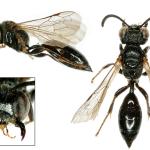Mimesa borealis DAHLBOM 1842; Mimumesa oresterus VAN LITH 1976; Mimesa palliditarsis SAUNDERS 1904
This species is morphologically very similar to M. littoralis. Recent appraisals of the differences between the two can be found in Else & Felton (1994) and a rigorous statistical examination in Budrys (2001). This species was only formally added to the British list by Else & Felton in 1994, although the species was first taken by O W Richards in 1950, but mis-identified as M. spooneri. This species is listed in older literature under the genus Psen.
First recorded from several of the famous chines on the Isle of Wight, this wasp is now known to occur also in South Hants, West Sussex, Kent, Oxfordshire and South Essex. It has been recorded from Jersey. Falk (1991) refers to records from Dorset, but this was a mis-identification of M. littoralis.
Overseas, the species is sporadic and rare in Fennoscandia, but widely distributed in Europe, Asia Minor and southern Siberia (Lomholdt 1984).
Listed (in the genus Psen) by Falk (1991) as Notable A, now referred to as Nationally Scarce (Na), although Shirt (1987) classified it as Rare (RDB3).
The Isle of Wight specimens were largely collected from damp, unstable cliff terraces caused by slumping. They were swept from the vegetation and seen flying amongst reed stems (Else & Felton 1994). In mainland Britain, as well as nesting in areas of damp, bare clay, it has also been observed flying over sandy ground in open woodland, from reed mire with dead wood present, and from the bottom of a chalk pit that had been filled with sand.
Late June to the latter half of August.
No data available.
There is a lack of published information on the nesting biology of M. unicolor. The few British observations are of females entering burrows in the ground.
The only observed visits to flowers were at Thorney Island, West Sussex, where they were seen at wild carrot (Else & Felton 1994).
No information available.
2005


